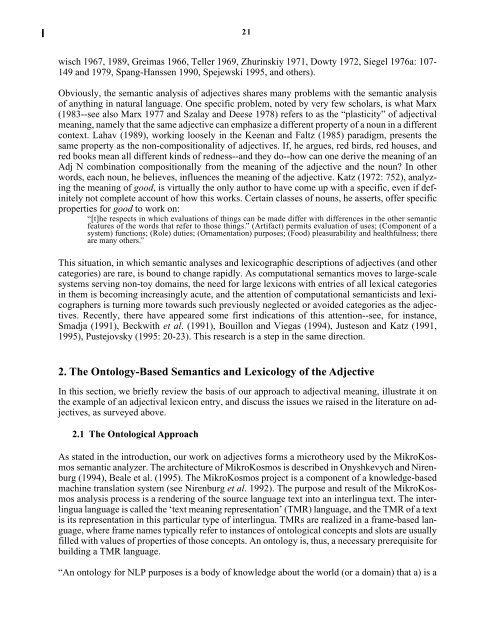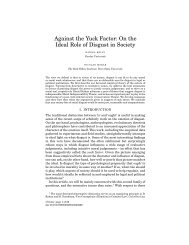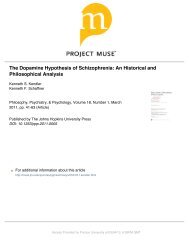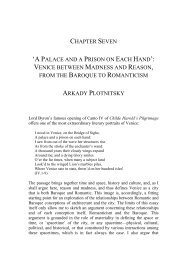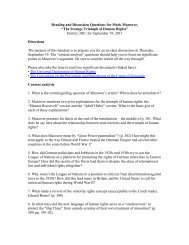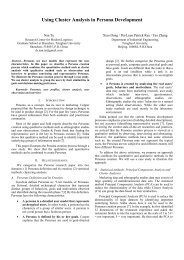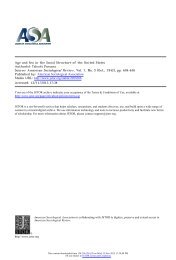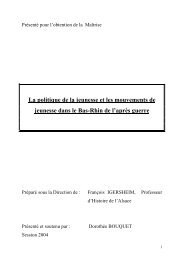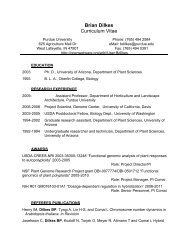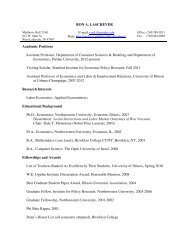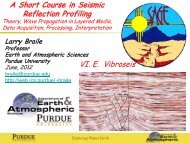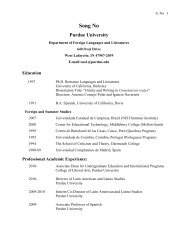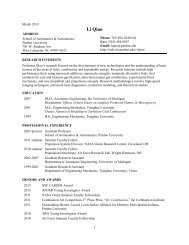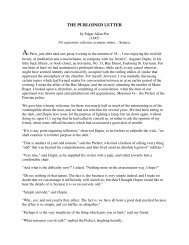Lexical Semantics of Adjectives - CiteSeerX
Lexical Semantics of Adjectives - CiteSeerX
Lexical Semantics of Adjectives - CiteSeerX
Create successful ePaper yourself
Turn your PDF publications into a flip-book with our unique Google optimized e-Paper software.
21<br />
wisch 1967, 1989, Greimas 1966, Teller 1969, Zhurinskiy 1971, Dowty 1972, Siegel 1976a: 107-<br />
149 and 1979, Spang-Hanssen 1990, Spejewski 1995, and others).<br />
Obviously, the semantic analysis <strong>of</strong> adjectives shares many problems with the semantic analysis<br />
<strong>of</strong> anything in natural language. One specific problem, noted by very few scholars, is what Marx<br />
(1983--see also Marx 1977 and Szalay and Deese 1978) refers to as the “plasticity” <strong>of</strong> adjectival<br />
meaning, namely that the same adjective can emphasize a different property <strong>of</strong> a noun in a different<br />
context. Lahav (1989), working loosely in the Keenan and Faltz (1985) paradigm, presents the<br />
same property as the non-compositionality <strong>of</strong> adjectives. If, he argues, red birds, red houses, and<br />
red books mean all different kinds <strong>of</strong> redness--and they do--how can one derive the meaning <strong>of</strong> an<br />
Adj N combination compositionally from the meaning <strong>of</strong> the adjective and the noun? In other<br />
words, each noun, he believes, influences the meaning <strong>of</strong> the adjective. Katz (1972: 752), analyzing<br />
the meaning <strong>of</strong> good, is virtually the only author to have come up with a specific, even if definitely<br />
not complete account <strong>of</strong> how this works. Certain classes <strong>of</strong> nouns, he asserts, <strong>of</strong>fer specific<br />
properties for good to work on:<br />
“[t]he respects in which evaluations <strong>of</strong> things can be made differ with differences in the other semantic<br />
features <strong>of</strong> the words that refer to those things.” (Artifact) permits evaluation <strong>of</strong> uses; (Component <strong>of</strong> a<br />
system) functions; (Role) duties; (Ornamentation) purposes; (Food) pleasurability and healthfulness; there<br />
are many others.”<br />
This situation, in which semantic analyses and lexicographic descriptions <strong>of</strong> adjectives (and other<br />
categories) are rare, is bound to change rapidly. As computational semantics moves to large-scale<br />
systems serving non-toy domains, the need for large lexicons with entries <strong>of</strong> all lexical categories<br />
in them is becoming increasingly acute, and the attention <strong>of</strong> computational semanticists and lexicographers<br />
is turning more towards such previously neglected or avoided categories as the adjectives.<br />
Recently, there have appeared some first indications <strong>of</strong> this attention--see, for instance,<br />
Smadja (1991), Beckwith et al. (1991), Bouillon and Viegas (1994), Justeson and Katz (1991,<br />
1995), Pustejovsky (1995: 20-23). This research is a step in the same direction.<br />
2. The Ontology-Based <strong>Semantics</strong> and Lexicology <strong>of</strong> the Adjective<br />
In this section, we briefly review the basis <strong>of</strong> our approach to adjectival meaning, illustrate it on<br />
the example <strong>of</strong> an adjectival lexicon entry, and discuss the issues we raised in the literature on adjectives,<br />
as surveyed above.<br />
2.1 The Ontological Approach<br />
As stated in the introduction, our work on adjectives forms a microtheory used by the MikroKosmos<br />
semantic analyzer. The architecture <strong>of</strong> MikroKosmos is described in Onyshkevych and Nirenburg<br />
(1994), Beale et al. (1995). The MikroKosmos project is a component <strong>of</strong> a knowledge-based<br />
machine translation system (see Nirenburg et al. 1992). The purpose and result <strong>of</strong> the MikroKosmos<br />
analysis process is a rendering <strong>of</strong> the source language text into an interlingua text. The interlingua<br />
language is called the ‘text meaning representation’ (TMR) language, and the TMR <strong>of</strong> a text<br />
is its representation in this particular type <strong>of</strong> interlingua. TMRs are realized in a frame-based language,<br />
where frame names typically refer to instances <strong>of</strong> ontological concepts and slots are usually<br />
filled with values <strong>of</strong> properties <strong>of</strong> those concepts. An ontology is, thus, a necessary prerequisite for<br />
building a TMR language.<br />
“An ontology for NLP purposes is a body <strong>of</strong> knowledge about the world (or a domain) that a) is a


